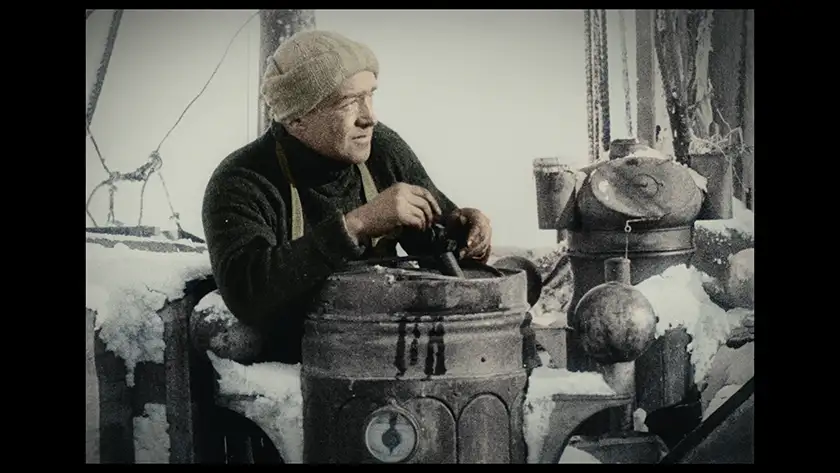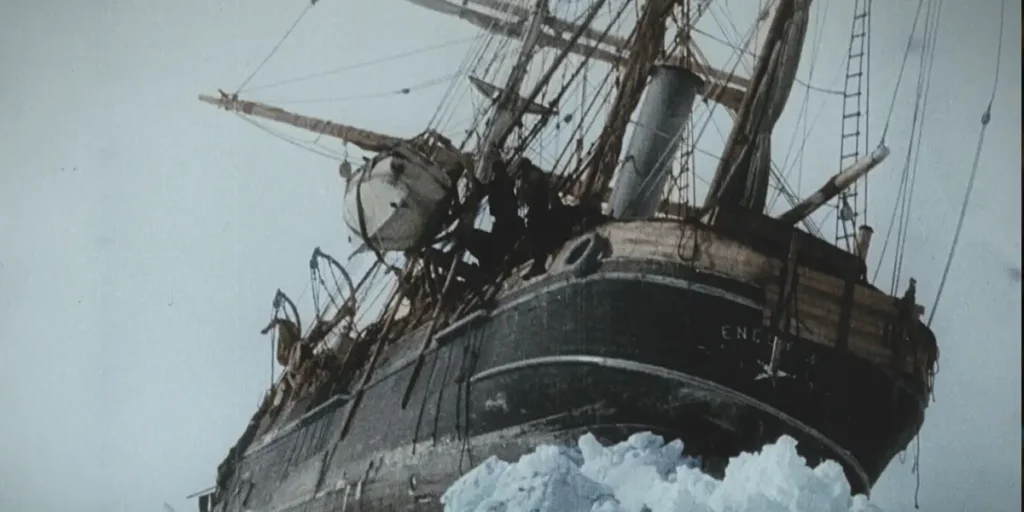Endurance is a tale of incredible courage from long ago brought to life, albeit with a dual narrative that gets in the way of the main story.
Directors: Elizabeth Chai Vasarhelyi, Jimmy Chin, Natalie Hewit
Genre: Documentary
Run Time: 100′
BFI London Film Festival Screening (World Premiere): October 12-14, 2024
U.S. Release Date: TBA
U.K. Release Date: TBA
When Ernest Shackleton bought the three-masted schooner barque ‘Polaris’, and renamed it ‘Endurance’, he set his own legacy in stone. Shackleton’s name is a byword for enduring hardship beyond normal human capacity, but not many people will know the full story of his and the Endurance’s disastrous 1914 expedition to the Antarctic, and the subsequent attempts to get back home. Endurance brings the details of this fateful voyage into sharp focus. Directors Elizabeth Chai Vasarhelyi, Jimmy Chan and Natalie Hewit give us a film that’s grounded in the grim realities of the voyage and its aftermath, and relatively free from embellishment.
The story of the Endurance fits nicely into the oeuvre of husband and wife filmmakers Chin and Vasarhelyi. After last year’s Nyad, which took a tale of achievement in the face of insurmountable odds and compressed it into a cookiecutter biopic template, they return to the documentary form that won them an Academy Award for Free Solo. That film boasted plenty of vertigo-inducing footage of free climber Alex Honnold’s feats, but it also felt like an extended exercise in boosting his ego. Working with Hewit, Endurance’s approach is more straightforward, using the records from the time, and those left behind by the crew, to craft its story. It acknowledges that Shackleton might have been driven by ego too (After being sent home early as an invalid by captain Robert Scott from the voyage of the ‘Discovery’ in 1903, he restlessly pursued a return to the Antarctic), but his ego might have been the reason we know so much about the expedition and the heroism it inspired.
After Amundsen reached the South Pole in 1911, and Robert Scott and his team perished in pursuit of the same goal, the race was on to make the first crossing of the Antarctic continent. To ensure the goal was on the record, Shackleton enlisted photographer Frank Hurley on the voyage. Hurley employed the latest camera technology for the time, including a camera to record film strips. The inclusion of Hurley’s photographs and film, now colourised, is the most poignant aspect of Endurance. Seeing the footage brings the expedition to life, while also underlining its futility. A wooden ship in the middle of the Weddell Sea was all but doomed to perish as the waters froze and refroze around it. Moments when the hull contorts and the masts snap are breathtaking in their capacity for humility.

The fears around the freezing of the seas drive the second story told in Endurance, namely the efforts to locate the sunken ship over a century later. In 2022, an expedition located the wreck of the Endurance on the seafloor, and the filmmakers accompanied the crew and scientists aboard the S.S. Agulhas II to capture the hunt. Several dives with a submersible camera unit had to be done over a two-week period before the sea froze over again, and potentially doomed the Agulhas II to a similar fate to the Endurance. The mind boggles at this prospect; the new ship is firmly constructed of steel, and is much bigger and better reinforced than Shackleton’s vessel, yet it still lives or dies by the whims of nature.
With this in mind, Endurance has more humility than Free Solo or Nyad. Instead, it has more in common with The Rescue, Chin and Vasarhelyi’s 2021 doc about the rescue of a young soccer team from a flooded cave in northern Thailand. Like Endurance, it reminds us that achieving great feats and breaking records in the face of nature is compelling enough, but merely surviving in nature can be a remarkable feat in itself.
As the story of Shackleton’s expedition continues, from escaping the collapsing ship, to the prolonged wait for rescue on Elephant Island, to the perilous voyage to actually find rescue, the photographs captured and the stories recounted from the crew’s diaries give pause. The crew of the Endurance were stretched to the limits of human suffering, plagued by the constant threats of exposure and starvation. However, this sits oddly against the relative comfort of the search for the shipwreck by the Agulhas II.
The directors give plenty of time to these efforts, including exploration of some of that expedition’s members. As accomplished as the careers of marine archaeologist Mensun Bound or subsea engineer Nico Vincent might be, the director’s efforts to integrate this story into the story of Shackleton’s crew feel forced. Finding the wreck of the Endurance was a feat, but the original tale of survival is much more compelling, with the more contemporary scenes slowing the film down.
Shackleton’s story is a lesson in crisis control, and inspiring others to carry on regardless (Shackleton’s mantra was “Patience, patience, patience.”) Endurance uses the relics of the voyage to illustrate an unbelievable story (though one can question the efficacy or ethics of using AI to recreate Shackleton and the crew’s voices to read their diary entries). Even if two stories are tripping over each other for space in Endurance, the stronger story still shines regardless. As we see the crew of the Aghulas II visit Shackleton’s grave on the island of South Georgia to commemorate him, the three documentarians acknowledge that few stories can match his for its courage, and they do right by him by detailing his and his crew’s bravery.
Endurance will be screened at the BFI London Film Festival on October 12-14, 2024. Read our list of 30 movies to watch at the 2024 BFI London Film Festival!

